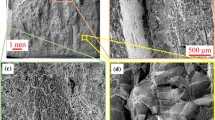Abstract
The effect of the fractality of a fracture surface and spall contour on the characteristics [fracture time (strength) and spall strength] of the loaded material is studied. It is shown that an increase in the fractal dimensions of the spall contour leads to an increase in the material strength parameter in the tensile wave and spall strength, whereas an increase in the fractal dimension of the fracture surface leads to a decrease in the spall strength. As an example, the spall strength is calculated taking into account the fractality of the fracture surface for Sp. 28 steel.
Similar content being viewed by others
References
B. L. Glushak, I. R. Trunin, S. A. Novikov, and A. I. Ruzanov, “Numerical modeling of spall fracture,” in: Fractals in Applied Physics [in Russian], Inst. of Exp. Phys., Arzamas-16 (1995), pp. 59–122.
V. S. Ivanova, Synergetrics: Strength and Fracture of Metals [in Russian] Nauka, Moscow (1992).
V. S. Ivanova, A. S. Balankin, I. Zh. Bunin, and A. A. Oksogoev, Synergetrics and Fractals in Materials Science [in Russian] Nauka, Moscow (1994).
B. K. Barakhtin, Yu. I. Meshcheryakov, and G. G. Savenkov, “Dynamic and fractal properties of SP-28 steel under high-velocity loading,” Zh. Tekh. Fiz., 68, No. 10, 43–49 (1998).
G. G. Savenkov, “Fractal-cluster model of spall fracture,” Zh. Tekh. Fiz., 72, No. 12, 44–48 (2002).
S. A. Atroshenko, S. A. Gladyshev, and Yu. I. Meshcheryakov, “Structural level scale mechanisms for fracture of dynamically loaded media,” in: Proc. 4-th All-Union Conf. on Detonation, Vol. 1, Telavi (1988), pp. 286–292.
Q. Y. Long, Li Suqin, and C. W. Lung, “Studies on the fractal dimension of the fracture surface formed by slow stable crack propagation,” J. Appl. Phys., 24, 602–607 (1991).
É. V. Kozlov, “Parameters of the mesosrtucture and mechanical properties of single-phase metallic materials,” Vopr. Materialoved., No. 1. 50–69 (2002).
V. N. Aptukov, “Two stages of spallation,” Combust., Expl., Shock Waves, No. 5, 631–636 (1985).
Yu. I. Fadeenko, “Temporal fracture criteria in solid-state dynamics,” in: Dynamics of Continuous Media (collected scientific papers) [in Russian], No. 32, Inst. of Hydrodynamics, Sib. Div., Russian Acad. of Sci., Novosibirsk (1977), pp. 95–122.
V. I. Betehtin, A. I. Petrov, and A. G. Kadomtsev, “Life, development, and curing of microcracks in metals,” in: Physics of Strength and Plasticity [in Russian], Nauka, Leningrad, (1986), pp. 41–48.
V. V. Novozhilov, “Necessary and sufficient criterion of brittle strength,” Prikl. Mat. Mekh., 33, No. 2, 212–222 (1969).
N. F. Morozov and Yu. V. Petrov, “Conception of structural time in dynamic fracture theory,” Dokl. Akad. Nauk SSSR, 324, No. 5, 964–967 (1992).
N. F. Morozov, Yu. V. Petrov, and A. V. Utkin, “On the calculation of the limiting intensity of pulsed loads,” Izv. Akad. Nauk SSSR, Mekh. Tverd. Tela, No. 5, 181–182 (1988).
A. G. Ivanov, “On possible causes of brittle fracture,” J. Appl. Mech. Tekh. Fiz., No. 3, 439–442 (1988).
H.-O. Peitgen and P. H. Richter, Beauty of Fractals: Images of Complex Dynamical Systems, Springer-Verlag (1945).
R. L. Salganik, “Mechanics of bodies with a large number of cracks,” Izv. Akad. Nauk SSSR. Mekh. Tverd. Tela, No. 4, 149–158 (1973).
A. G. Ivanov (ed.), Fracture of Objects of Different Scales in Explosion [in Russian], Inst. of Exp. Phys., Sarov (2001).
V. V. Zosimov and L. M. Lyamshev, “Fractals in wave processes,” Usp. Fiz. Nauk, 165, No. 4, 361–401 (1995).
A. A. Éfros, Physics and Geometry of Disorder [in Russian] Nauka, Moscow (1982).
G. G. Savenkov,“Deformation and fracture mechanisms of plastic and rigid bodies under high-velocity interaction,” Doct. Dissertation in Tech. Sci., Saint Petersburg (2003).
Author information
Authors and Affiliations
Corresponding author
Additional information
__________
Translated from Prikladnaya Mekhanika i Tekhnicheskaya Fizika, Vol. 50, No. 6, pp. 61–69, November–December, 2009.
Rights and permissions
About this article
Cite this article
Barakhtin, B.K., Savenkov, G.G. Relationship between spall characteristics and the dimension of fractal fracture structures. J Appl Mech Tech Phy 50, 965–971 (2009). https://doi.org/10.1007/s10808-009-0130-y
Received:
Revised:
Published:
Issue Date:
DOI: https://doi.org/10.1007/s10808-009-0130-y



